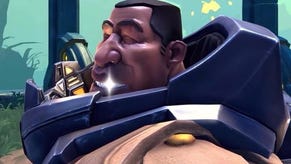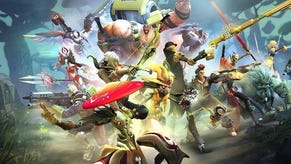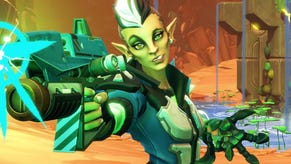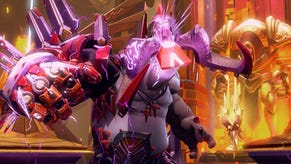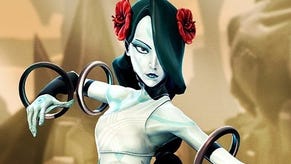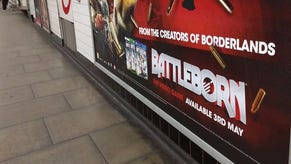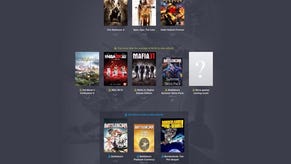Gearbox's Battleborn throws the FPS and MOBA genres together
But the mix looks like it'll take some time to get right.
For a moment, I'm not sure if I'm attending a preview event run by Pixar. Gearbox Software are talking so much about their characters - about their pride in their characters, about designing and writing and keyframe animating their characters - and all the while there's footage of these cartoonish creations blasting and hacking and leaping and wisecracking their way through hordes of robot enemies. I could be watching a video game play out in front of me but, equally, I could also be watching a Saturday morning TV show. One of the good ones, mind, but also one of the weirder ones. One of the first things that creative director Randy Varnell says, with pride, is "We've got a fighting mushroom."
He's right. There's a sort of humanoid fungus that hurls what I think are spores at its enemies. There's also a gigantic soldier with a tiny head and a samurai vampire, among others. "We love making characters," continues Varnell, as he introduces Battleborn. "And enemies. And universes. And we love blending genres. We also love playing co-op." Indeed, shortly after an introductory video, Gearbox shows a demonstration level, with five of their staff playing through it together as five quite distinct characters, vampire and mushroom included. Our main perspective is from that of your rather typical shooter marine dudebro. This character is Gearbox's attempt to present the most generic and stereotypical shooter character, but then subvert that. This one's a bit of an idiot.
There's a tremendous amount of shooting as the five dash their way through a large, Gothic arena, a sort of open-plan metallic castle set across many tiers, with pulsing jump pads and blood-red skies. Armies of drones surge forward and a giant robot spider leaps down from above. Things explode a lot.
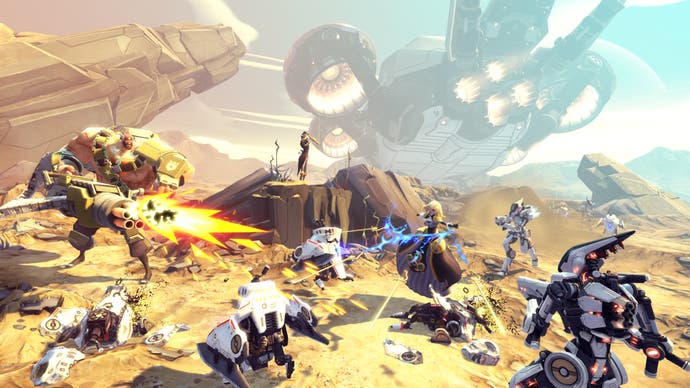
Gearbox is calling Battleborn a "space fantasy." To the rest of us, it looks like a very stylised space opera, with a suitably high stakes plot (all the stars in the universe bar one have died) and a curious mix of futuristic technologies, magic powers and bizarre factions. Gentleman robots in bowler hats, the arms dealers of the galaxy, sell to space elves and unaligned pirate factions. "A dark and mysterious group from another universe," seem to be accelerating the heat death of the universe. There's clearly a lot invested in creating both Battleborn's plot and its personalities.
Gearbox is also calling Battleborn a "hero shooter," a particular flavour of FPS that they see as very much based around its characters, their personalities and their markedly distinct powers. That gigantic soldier, with his enormous growling minigun, will play very differently to that samurai vampire, a melee character who steals life from his opponents. As well as an extensive co-op campaign, where these characters will combine their contrasting powers to wreak all flavours of havoc, Varnell says that Gearbox is working on "several other multiplayer modes." A short video demonstrates a five versus five competitive mode called Incursion, where both teams attempt to capture giant robot spiders and use these to aid them in making their way toward, and eventually wrecking, the enemy's base. There's a whiff of MOBA in the air at this point and, though nobody from Gearbox uses that to describe any part of the game, they do acknowledge the influence.
It's particularly felt, says design director John Mulkey, in the game's RPG mechanics and its attitude towards levelling. Rather than long periods between levels where characters slowly accrue experience, in each game or section of Battleborn players can expect to level up "every couple of minutes," picking one of two new powers each time. These aren't simply stat boosts, but instead offer distinct character builds that present new abilities and new ways to play. "Montana, for instance," he says, referring to the micro-headed giant, "has a gatling gun that can fire ice bullets. What happens when you hit things with ice bullets is they start to freeze, they slow down. You can have situations where he pairs up with a sniper, sprays ice bullets and then the sniper's picking everything off."

Some of this is about creating moments where players combine powers, says Mulkey, "Where you say 'Hey, do that for me! I'm gonna do this!'" But the philosophy is also to present players with options. "The way you level up is more broad than tall," he continues. "You give players all kinds of things to try." Rather than simply becoming more powerful, characters can become more flexible. Mulkey hopes this will help to make the game accessible and give players of all abilities and tastes a chance to find something they enjoy.
Of course, it's impossible to look at Battleborn and not see the influence of Borderlands 2, Gearbox's enormously successful predecessor. They certainly share much of the same DNA, combining RPG and FPS elements and dressing them in stylish, melodramatic presentation. Randy Pitchford, Gearbox's president, doesn't make himself available for interview, but he is the man who introduces Battleborn and he presents it as the developer refusing to remain comfortable and reaching forward to something new. It's a decision that he says presents an element of risk.
"The best way to take the next leap is to abandon the constraints that we've created for ourselves," he says. "When we announced Borderlands, there were a lot of folks who would say to me 'Why're you even starting Borderlands when Brothers in Arms is so successful? Shouldn't you put everything you have behind that?'" Both Randys pitch Battleborn as a significant investment of the developer's time, energy and passion, suggesting it's something they hope will reward them as much as Borderlands 2 has, but which will also be bigger in every way. Pitchford and Varnell reveal nine playable characters and Varnell suggests there could be twice as many featured upon release, each of them a substantially developed and very distinct personality. "Each character that we're creating," Mulkey later says, "is fleshed out to the degree that they could be the lead character in their own game."
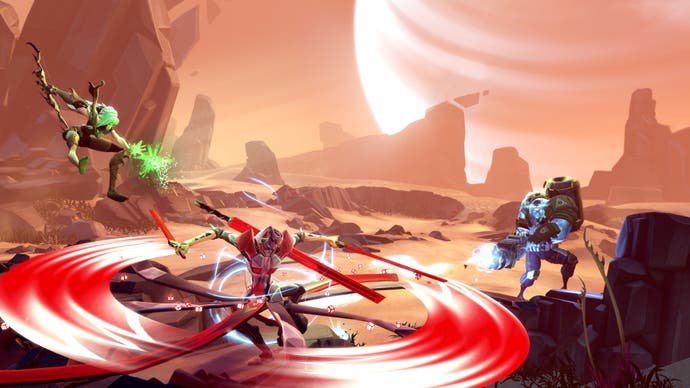
The team see diversity as a chance to be enormously creatively indulgent and also the antidote to unoriginality. "From the very start of the project, we let our concept artists just explode," says Varnell. "We're like 'Okay, imagine... everything!' For a concept artist, it's a dream, because usually they're so focused on making something very specific, but when we started Battleborn we really cast the net wide. We said, just imagine characters that you can pull from anywhere."
It was an invitation welcomed by team members like art director Scott Kester, who were allowed to not only draw characters, but develop concepts for how they should play and feel and thus feel particularly invested in them. Kester was personally responsible for Rath, the sword-wielding vampire, which brought an increasing emphasis on first-person melee. "Most places would be like, 'Okay, art guy! We'll have our designers take over now,'" he says, "but what happens is you force their hand. You've got to have good first-person melee now. It gives the whole team freedom to push for their personal ideas. It's not just my game, it's our game, all our influences. Everybody has something. Everybody has several things."
Kester says that a wide variety of influences, from both games and films, has created what he feels are unusual and very original crossovers. He's personally very proud of the metallic castle seen in the demo, something he calls "A merge of Gothic architecture and Tron. I didn't want to do the typical FPS thing, this super-dead, desaturated thing where it was grey and raining all the time." Instead, he drew on old-school influences and to many his Gothic Tron level will look familiar. Its open spaces and deliberately angular design reference Quake 3. Kester adds that many other levels will demonstrate not just different art styles, but different design and layout philosophies.

Gearbox believes all this diversity in their approach will also be one of the ways it'll connect with their player base. They're keen to talk about their experiences meeting cosplayers and fans, who have been particularly enthusiastic about many of the strange and singular characters in Borderlands 2, a cast created with a deliberate attempt to be diverse and inclusive. While there's not a "quota" or an attempt to "check boxes" in Battleborn's cast, Kester says, "diversity is just what feels right."
Varrell promises that, as well as more playable characters ("They get weirder and wilder. We get into some really weird stuff, out of the humanoid into really different things"), there will be more game modes, more environments and potential expansions after release. I ask Mulkey about how all this might work, pointing out the free-to-play possibilities, but he talks about a similar model to Borderlands 2: a boxed release followed by substantial DLC.
Gearbox has already spent a couple of years gelling Battleborn together, says Varnell, starting the project right after Borderlands 2. The team reckons they're looking to release some time in 2015, but that's a broad window they're not worried about narrowing yet. Much more important to them is the game's balance and consistency. All those diverse ingredients present tremendous potential, but they're still being blended. It will be some time yet until they're smooth.


